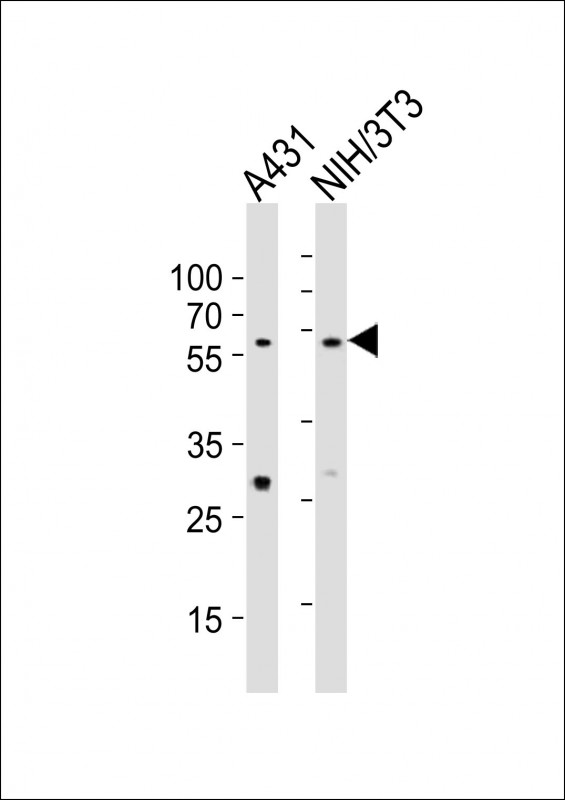(Mouse) Eed Antibody (Center)
Purified Rabbit Polyclonal Antibody (Pab)
- 产品详情
- 实验流程
- 背景知识
Application
| WB, IHC-P, E |
|---|---|
| Primary Accession | Q921E6 |
| Reactivity | Human, Rat, Mouse |
| Host | Rabbit |
| Clonality | polyclonal |
| Isotype | Rabbit IgG |
| Calculated MW | 50198 Da |
| Gene ID | 13626 |
|---|---|
| Other Names | Polycomb protein EED, Eed |
| Target/Specificity | This mouse Eed antibody is generated from a rabbit immunized with a KLH conjugated synthetic peptide between 269-303 amino acids from the Central region of mouse Eed. |
| Dilution | WB~~1:1000 IHC-P~~1:100~500 E~~Use at an assay dependent concentration. |
| Format | Purified polyclonal antibody supplied in PBS with 0.09% (W/V) sodium azide. This antibody is purified through a protein A column, followed by peptide affinity purification. |
| Storage | Maintain refrigerated at 2-8°C for up to 2 weeks. For long term storage store at -20°C in small aliquots to prevent freeze-thaw cycles. |
| Precautions | (Mouse) Eed Antibody (Center) is for research use only and not for use in diagnostic or therapeutic procedures. |
| Name | Eed |
|---|---|
| Function | Polycomb group (PcG) protein. Component of the PRC2/EED-EZH2 complex, which methylates 'Lys-9' and 'Lys-27' of histone H3, leading to transcriptional repression of the affected target gene. Also recognizes 'Lys-26' trimethylated histone H1 with the effect of inhibiting PRC2 complex methyltransferase activity on nucleosomal histone H3 'Lys-27', whereas H3 'Lys-27' recognition has the opposite effect, enabling the propagation of this repressive mark (By similarity). The PRC2/EED-EZH2 complex may also serve as a recruiting platform for DNA methyltransferases, thereby linking two epigenetic repression systems (By similarity). Genes repressed by the PRC2/EED- EZH2 complex include HOXA7, HOXB6 and HOXC8. Plays a role in X chromosome inactivation (XCI), in which one of the two X chromosomes in female mammals is transcriptionally silenced to equalize X-linked gene dosage with XY males. Required for stable maintenance of XCI in both embryonic and extraembryonic tissues. May prevent transcriptional activation of facultative heterochromatin during differentiation. Required for development of secondary trophoblast giant cells during placental development. May regulate hippocampal synaptic plasticity in the developing brain. |
| Cellular Location | Nucleus. Chromosome. Note=Localizes to the inactive X chromosome in cells of the early embryo and in stem cells of the extraembryonic trophectoderm lineage. Recruitment to the inactive X-chromosome requires XIST |
| Tissue Location | Expressed in brain, heart, kidney, liver, lung, muscle, ovary, spleen and testis. Expressed throughout the brain |
For Research Use Only. Not For Use In Diagnostic Procedures.
Provided below are standard protocols that you may find useful for product applications.
BACKGROUND
Polycomb group (PcG) protein. Component of the PRC2/EED- EZH2 complex, which methylates 'Lys-9' and 'Lys-27' of histone H3, leading to transcriptional repression of the affected target gene. Also recognizes 'Lys-26' trimethylated histone H1 with the effect of inhibiting PRC2 complex methyltransferase activity on nucleosomal histone H3 'Lys-27', whereas H3 'Lys-27' recognition has the opposite effect, enabling the propagation of this repressive mark (By similarity). The PRC2/EED-EZH2 complex may also serve as a recruiting platform for DNA methyltransferases, thereby linking two epigenetic repression systems (By similarity). Genes repressed by the PRC2/EED-EZH2 complex include HOXA7, HOXB6 and HOXC8. Plays a role in X chromosome inactivation (XCI), in which one of the two X chromosomes in female mammals is transcriptionally silenced to equalize X-linked gene dosage with XY males. Required for stable maintenance of XCI in both embryonic and extraembryonic tissues. May prevent transcriptional activation of facultative heterochromatin during differentiation. Required for development of secondary trophoblast giant cells during placental development. May regulate hippocampal synaptic plasticity in the developing brain.
REFERENCES
Shumacher A.,et al.Nature 383:250-253(1996).
Schumacher A.,et al.Nature 384:648-648(1996).
Denisenko O.N.,et al.Mol. Cell. Biol. 17:4707-4717(1997).
Carninci P.,et al.Science 309:1559-1563(2005).
Denisenko O.N.,et al.Mol. Cell. Biol. 18:5634-5642(1998).
终于等到您。ABCEPTA(百远生物)抗体产品。
点击下方“我要评价 ”按钮提交您的反馈信息,您的反馈和评价是我们最宝贵的财富之一,
我们将在1-3个工作日内处理您的反馈信息。
如有疑问,联系:0512-88856768 tech-china@abcepta.com.























 癌症的基本特征包括细胞增殖、血管生成、迁移、凋亡逃避机制和细胞永生等。找到癌症发生过程中这些通路的关键标记物和对应的抗体用于检测至关重要。
癌症的基本特征包括细胞增殖、血管生成、迁移、凋亡逃避机制和细胞永生等。找到癌症发生过程中这些通路的关键标记物和对应的抗体用于检测至关重要。 为您推荐一个泛素化位点预测神器——泛素化分析工具,可以为您的蛋白的泛素化位点作出预测和评分。
为您推荐一个泛素化位点预测神器——泛素化分析工具,可以为您的蛋白的泛素化位点作出预测和评分。 细胞自噬受体图形绘图工具为你的蛋白的细胞受体结合位点作出预测和评分,识别结合到自噬通路中的蛋白是非常重要的,便于让我们理解自噬在正常生理、病理过程中的作用,如发育、细胞分化、神经退化性疾病、压力条件下、感染和癌症。
细胞自噬受体图形绘图工具为你的蛋白的细胞受体结合位点作出预测和评分,识别结合到自噬通路中的蛋白是非常重要的,便于让我们理解自噬在正常生理、病理过程中的作用,如发育、细胞分化、神经退化性疾病、压力条件下、感染和癌症。







